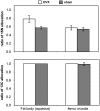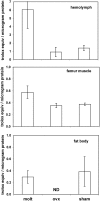Allocation of nutrients to somatic tissues in young ovariectomized grasshoppers
- PMID: 21558244
- PMCID: PMC3140271
- DOI: 10.1093/icb/icq105
Allocation of nutrients to somatic tissues in young ovariectomized grasshoppers
Abstract
The disposable soma hypothesis predicts that when reproduction is reduced, life span is increased because more nutrients are invested in the soma, increasing somatic repair. Rigorously testing the hypothesis requires tracking nutrients from ingestion to allocation to the soma or to reproduction. Fruit flies on life-extending dietary restriction increase allocation to the soma "relative" to reproduction, suggesting that allocation of nutrients can be associated with extension of life span. Here, we use stable isotopes to track ingested nutrients in ovariectomized grasshoppers during the first oviposition cycle. Previous work has shown that ovariectomy extends life span, but investment of protein in reproduction is not reduced until after the first clutch of eggs is laid. Because ovariectomy does not affect investment in reproduction at this age, the disposable soma hypothesis would predict that ovariectomy should also not affect investment in somatic tissues. We developed grasshopper diets with distinct signatures of ¹³C and ¹⁵N, but that produced equivalent reproductive outputs. These diets are, therefore, appropriate for the reciprocal switches in diet needed for tracking ingested nutrients. Incorporation of stable isotopes into eggs showed that grasshoppers are income breeders, especially for carbon. Allocation to the fat body of nitrogen ingested as adults was slightly increased by ovariectomy; this was our only result that was not consistent with the disposable soma hypothesis. In contrast, ovariectomy did not affect allocation of nitrogen to femoral muscles. Further, allocation of carbon to the fat body or femoral muscles did not appear to be affected by ovariectomy. Total anti-oxidant activities in the hemolymph and femoral muscles were not affected by ovariectomy. These experiments showed that allocation of nutrients was altered little by ovariectomy in young grasshoppers. Additional studies on older individuals are needed to further test the disposable soma hypothesis.
Figures





References
-
- Boggs CL. Understanding insect life histories and senescence through a resource allocation lens. Funct Ecol. 2009;23:27–37.
-
- Caut S, Angulo E, Courchamp C. Caution on isotopic model use for analyses of consumer diet. Can J Zool. 2008;86:438–45.
-
- Chapman R. The insects: structure and function. 4th. Cambridge, UK: University Press; 1998.
-
- Cerling TE, Harris JM. Carbon isotope fractionation between diet and bioapatite in ungulate mammals and implications for ecological and paleoecological studies. Oecologia. 1999;120:347–63. - PubMed
Publication types
MeSH terms
Grants and funding
LinkOut - more resources
Full Text Sources

